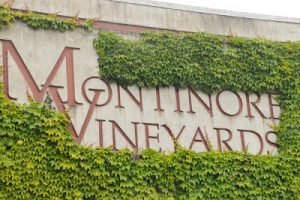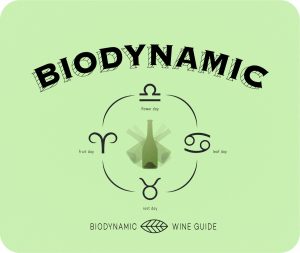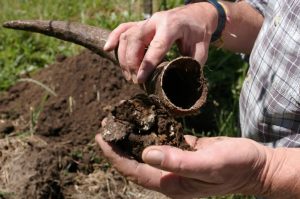Healthy Soil, Healthy Vines, Tasty Wines
A year in a Biodynamic® Vineyard
So, you have to bury cow’s horns filled with fermented cow dung preferably from a lactating cow (BD 500), 18 inches below the surface during the cooler months. And sure, you have to bury finely ground quartz crystals (BD 501) in the cow’s horns during the hot time of the year to prepare the soil. But not to worry, there are companies you can buy these from. Biodynamics® is much more than that. It’s about taking your land that isn’t healthy and infusing it with energy and life force. It’s about composting and strengthening your soil. After all, the word biodynamic is derived from the Greek bios (life) and dynami (energy).
In 1924, Dr. Rudolf Steiner held a series of lectures presenting a farm as a living organism: self-contained and self-sustaining, responsible for creating and maintaining its individual health and vitality. This was transcribed into a book titled “Agriculture”. From here he created a method of biodynamic® farming that today is overseen by the U.S. Demeter Association. If a commercial farm or product wants to label themselves biodynamic® they must be certified through this organization. This certification ensures the protection of Biodynamic® agriculture and the ultimate vision of healing the planet through agriculture.
Peter and Rebecca Work of Ampelos Cellars in Lompoc, California believe that wine is made in the vineyard. After their second harvest in 2005 when they asked their vineyard consultant what they could do to make their vineyard and clusters even better. He recommended that they look into organic and biodynamic farming. So, that’s exactly what they did. They read the works of Dr. Rudolf Steiner, and decided this philosophy agreed with theirs and by spring 2006 they were ready to move forward.
The basic principles of Biodynamic ® farming are:
- Enrich soil’s organic matter in order to retain the fertility in the form of humus (the organic component of soil, formed by the decomposition of leaves and other plant material by soil microorganisms).
- Enhance and maintain the living system by increasing the macro and microbial activity in the soil
- Improve soil organic matter in terms of quantity, but also use it skillfully as the basic factor of soil life
- Restore the balance in the system and function with the living and non-living
- Advocate greater attention to the importance and role of hormones and enzymes in the system, in addition to major mineral elements and trace elements
- Ensure proper crop rotation with exhausting and fertility restoring crops Consider the use of cover crops, green manuring and mulching
- Focus on water balance and control of soil erosion, deforestation and industrial product pollution
- Soil is not only a chemical, mineral or organic system, but it also has a physical structure. The maintenance of a crumbly, deep, well-aerated structure is an absolute must for good soil fertility.

Rudy Marchesi of Montinore Vineyards in the Willamette Valley in Oregon is the nation’s second largest estate producer of wines made from biodynamic® grapes. He first experienced the farming method in vegetable farming and later in French biodynamic® vineyards. He decided to take a year-long training course at the Pfeiffer Center in New York and upon instigating the farming method saw immediate and dramatic results.
Rudy joined a study group  with other local growers/winemakers who were on the same path. “We had regular study group meetings to help each other learn and advance. It was a small group but it was very helpful in the beginning. Of course, we were a tiny minority and many people thought that we were a little crazy or just looking for a marketing advantage. More than once I was accused of putting ‘fairy dust’ on my vineyards,” Marchesi said.
with other local growers/winemakers who were on the same path. “We had regular study group meetings to help each other learn and advance. It was a small group but it was very helpful in the beginning. Of course, we were a tiny minority and many people thought that we were a little crazy or just looking for a marketing advantage. More than once I was accused of putting ‘fairy dust’ on my vineyards,” Marchesi said.
At Montinore Estate “Our biggest challenge was adapting to the scale of our operations. With 240 acres of vineyards so it took some time, creativity and perseverance,” Rudy said. “We needed to mechanize certain operations, like the stirring process for the vineyard sprays, without losing the potency of personal attention and engagement. We had to make larger quantities of preparations than I had before and learn how to apply them in an efficient manner. We started building compost piles producing hundreds of tons of material so there was a learning curve and refinement in that process. We were greatly helped by a great biodynamic consultant, Philippe Armenier from Santa Rosa CA, who had done a lot of work in Chateauneuf du Pape and California. No one variety seemed to respond better than another. By 2007 we started following the Demeter biodynamic guidelines in the winery. Not only did we see a change in the health of the vineyard but also we saw an evolution in the character and quality of our wines,”
“We are growing grapes like everybody else so the cycle of the plant is determined by the plant not the method. That being said we see the significance of the annual cycles a little differently. We will work on nutritional aspects during dormancy in expectation of the growing season. We work to stay attuned to the seasonal cycles of solstice and equinox and use the ebb and flow of plant growth energy at those times to the best advantage of our vines,” Rudy said.
A year in a Biodynamic® estate
January – In the beginning of the month we spray the perimeter of the farm with a special mix of herbs to mark our boundaries and in a way signal to the life forces our intent for the year and thanks for the help. We also start the pruning.
February – This month is for pruning and tending to our compost to make sure it is developing appropriately.
March – Root activity starts again as the soils warm. This is when we spray BD500, which is a tea of composted cow manure, on the soil below the vines. We usually do two applications about two weeks apart but sometimes three if needed.
April – We observe bud break and new shoot growth and make additional applications of compost if we see a need. This is also when we dig up our composted BD 500 from the previous fall, clean and store it for the next spring. We also start vine leaf sprays to enhance vine health and help fend off mildew. This is also a time when we do a deep cultivation in every other vine row to break up soil compaction and let oxygen permeate the soil allowing for the growth of the desired aerobic soil organisms. Lastly, we prepare the BD501 silica spray for the following year.
May – This month is a usual month with grape-growing tasks of cultivation around the vines and the hand work of removing extra shoots.
June – This month is a critical time when our vines bloom and we apply our first spray of BD 501. Timing of this is weather dependent and earlier sprays of BD 501 can help in cooler years. This is also the time of the summer solstice so we need to ensure that our vines are in peak health to take full advantage of the long days of sunlight and bloom and set fruit in a way that gives us a good crop.
July and August – Here we focus on keeping the vines clean and healthy and the fruit developing. Depending on weather and the character of the vine growth for that year we may need additional sprays of BD 501.
September – By this time the vines are well on their way toward harvest. We should be seeing color change in the grapes and sugar development. In cooler years this would be a time to apply Valerian or even more BD501 to try to accelerate color change and the process of ripening. This is when we prepare and start the composting of the BD 500.
October – This month is devoted to harvest and winemaking.
November – We begin building our compost piles using a mix of pressed grape skins, collected leaves, straw and other plant materials and manure from our neighbors’ animals. Once the piles are built we monitor the internal temperature to ensure they aren’t getting too hot and killing off the beneficial organisms and turning is necessary to bring in air and cool off the piles. At this time there is also a last flush of root activity when root hairs grow and the vines are storing nutrients for the following spring this is when we do our fall soil spray of BD 500. This is also the time we apply the previous years’ compost to the vineyards.
December – Once the compost piles have slowed down their initial burst of activity we add the BD preparations 502 through 507 to the piles as “starter” substances to help in the production of the various nutritional components needed for healthy vine growth.
“I think the biggest difference in farming with biodynamic practices is that we train our observation skills to be highly attuned to all aspects of the vines physical character, i.e. color, gesture, growth, general physical posture. We taste different parts of the plant to determine the ‘quality’ of the growth. Our own senses are our best tools once they are refined for the task,” Marchesi said.
“Biodynamic farming is a very proactive, very deliberate activity in which you engage in additional action to bring life and health to your farm. Vineyards grown with biodynamic practices tend to have less variation in wine character than chemically grown, irrigated vines. With deeper roots and balanced growth they are somewhat more resistant to the extremes in weather. Biodynamic vines do, however, tend to express more of the place they are grown as opposed to a vintage.
Ultimately it’s about doing what’s right for your land, your property and taking care of Mother Earth.




